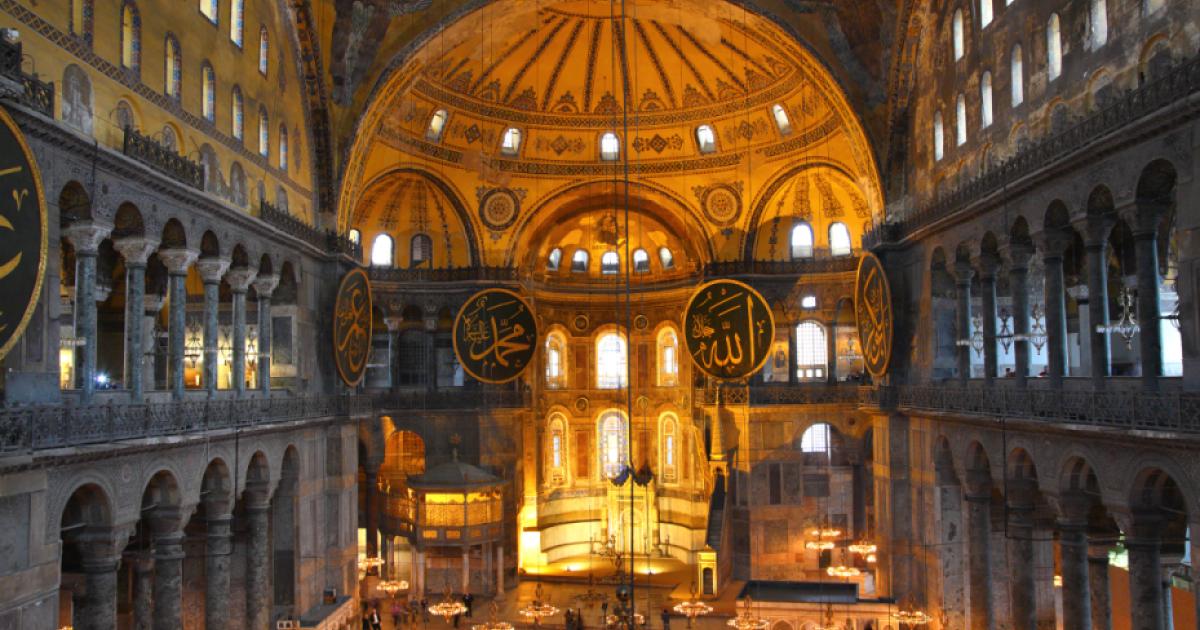Every contributor to this special issue of The Caravan dedicated to the memory of Fouad Ajami will have wondered “What would Fouad be thinking of now?”
Fouad’s capacious mind would be returning to the question “Have we just witnessed a turning point?” This in the context of Jürgen Habermas’s, The Liberating Power of Symbols, and C.S. Lewis’s assertion that
“Symbols are the natural speech of the soul, a language older and more universal than words.”1
If so, what symbolic moment has just occurred? President Erdoğan of Turkey has annulled the law that made Hagia Sophia, the church of Holy Wisdom in Istanbul, one of the world’s greatest architectural works of genius, into a mosque – praying there and declaring the church to be a mosque, open for Islamic prayers as of July 2020.
This essay is about architecture, the full significance of which needs more attention. A substantial architectural structure is uniquely representative of a city, a culture, a civilization. Politics, philosophy, money, art, popular understanding and acceptance, location, etc. all must be gathered and internally made coherent for the difficult task of erecting such a symbol of the society and state.
In this context, Hagia Sophia stands for Christianity or Christendom in the largest, grandest sense. Of all the “big thinkers” of modern times it is Oswald Spengler who most compellingly places architecture at the center of his examinations of the human condition. Spengler spans the East and West in his analysis; the bridge is the architectural category of the dome, which is both Arabian-Islamic and European-Christian, and at the same time both pre- and post-modern:
The Arabian (that is, the Early-Christian Byzantine) cupola-church…that seems to float on high above the basilica or the octagon, was indeed also a victory over the principle of natural gravity which the Classical expressed in architecture and column…
Here we come upon a critical duality. In the West, there is the Parthenon of ancient Athens and the Pantheon of Rome, the first is columned, the second is domed. Spengler describes this as a natural, organic development of form in the ancient Middle East from the long and rectangular to “the definite roof that is emphasized.”2 The dome as a form moves (is adopted) from East to West. In this view, Spengler says, “the masterpiece, the earliest of all Mosques, is the Pantheon as rebuilt by Hadrian. Here, without a doubt, the emperor was imitating, for the satisfaction of his own taste, cult-buildings he had seen in the East.” The architecture of the central-dome is that “in which the Magian (Spengler’s term for the ancient Middle East) world-feeling achieved its purest expression,” extending beyond the limits of the Roman Empire.
In the United States, the two contrasting architectures are seen in the state legislature of Virginia’s Parthenon shape and the great domes of St. Peter’s in Rome, St. Paul’s in London, and the capitol dome over the Houses of Congress in Washington, D.C.
Fouad Ajami, in pondering Erdogan’s symbolic act, would think of Fouad’s revered mentor, Bernard Lewis, who opens his major collection of essays “Interpreting the Middle East” (From Babel to Dragomans) with a powerful essay on “An Islamic Mosque,”3 Lewis, in just three pages, sees deep meaning in the Süleymaniye Mosque in Istanbul, the supreme masterpiece of the great Ottoman architect Mimar Sinan (1489-1588), the great dome of which “clearly owes much to the example of Santa Sophia” but technical engineering innovations gave added strength to the dome, thereby “clearing the central space under it of pillars and other encumbrances, and thus to obtain the wide extension needed for Muslim worship.”
Fouad would wonder “Why pray in Santa Sophia when the great Süleymaniye Mosque was right next to it, a Mosque to be used as a mosque? The reason of course is in Habermas’s book titled: The Liberating Power of Symbols.
The dome, as a form, in moving from the Arab Islam East to the Christian West, carried with it as the power of its symbol divine authorization, “the divine right of kings” in the pre-modern era now bestowed on governmental entities of all kinds.
War is the continuation of politics by other means, Clausewitz said. A corollary is that “liberation” of symbols is religious war by other means. The other side of liberation is intimidation. By going into the grand symbol of Christendom to turn it into a mosque is to seize the most prominent symbol of the other faith imaginable. The dome as the structure’s most commanding symbol conveyed to the world a theological legitimacy and authorization implying Erdoğan knew exactly what he was doing: “We can take it from you any time we want” he was saying by his action: we are taking back the dome in all its profound meaning.
Fouad would think: this is a reference point if not a turning point; it will be referred to in thought in the times to come.
Consider for a moment – in imagination only – a comparable but counter-action: the holding of Christian prayer in the Dome of the Rock on the Haram-al-Sharif.
It is not possible to fully understand the relation of East and West in world order, or the importance of legitimacy in governance, or as C.S. Lewis said, the language of the individual soul and of the collective mind of humanity, without grasping the significance of the architectural form of “the dome.”
















